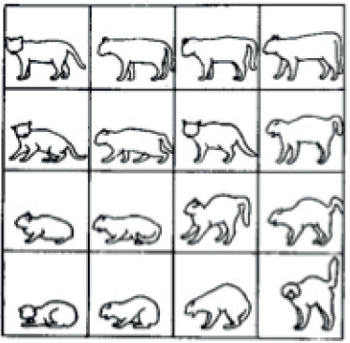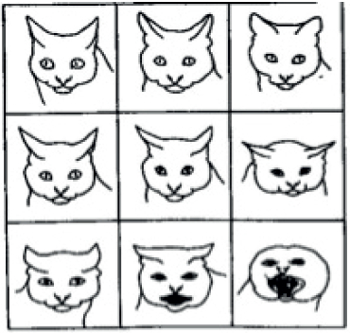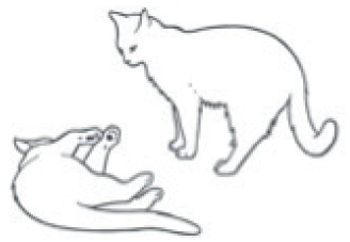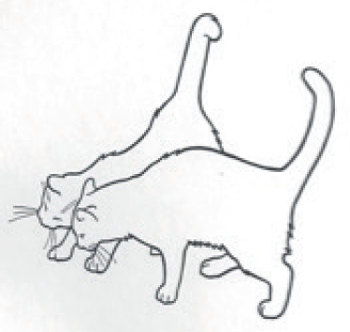Department of Veterinary Clinical Sciences, College of Veterinary Medicine, Purdue University, West Lafayette, IN, USA
1. Feline Body Language and Communication
Feline body language and its communication are directly related to their social behavior. Unlike dogs that are a highly social species domesticated a long time ago, cats are considered a semi-domesticated species whose physical and behavioral characteristics are only slightly modified from their ancestors.
Agonistic Behavior
Feline body language, especially agnostic behaviors, as evidenced in a classically known study of Leyhausen (1956), is primarily visible through its ears, tail, body posture and pupils (Figure 1 and 2). For example, when their ears are back and flat with crouching posture, the cat shows more fear and vulnerability. When a cat displays offensive aggression, its body posture stands forward with its ears erect. Understanding feline body language will help owners and veterinary staff to speculate on their emotions and to interact with cats in a more appropriate manner. However, it is still not clear if all of these agonistic body languages indeed influence a cat's behavior. Unlike canine species that hunted in groups on the open prairie, feline ancestors resided in the forest, where they hid and ambushed their prey in a solitary attack. Accordingly, when cats encounter confrontation, they prefer to run away rather than negotiate or fight. This important characteristic of social behavior in cats means they can be vulnerable to social confrontation. Cats unquestionably need to have sufficient hiding spots in their environment to co-habit with other individuals. Optimal environmental parameters for cats are discussed in later section.
| Figure 1 | 
|
|
| |
| Figure 2 | 
|
|
| |
Affiliative Behavior
There are certain postures and behaviors that are known to promote affiliative behavior in cats. When a female rolls to a male accompanied by purring, stretching and object rubbing it is a part of sexual behavior. When an immature male rolls to a mature male, it is considered an appeasement behavior coincident with the mature male ignoring or tolerating the immature male's presence (Figure 3).
| Figure 3 | 
|
|
| |
Interestingly, has been confirmed that a tail-up posture is a signal of intention of amicable interaction that serves an important role in cat-cat interaction. If both cats agree regarding friendly interaction, both raise their tail then rub against each other (Figure 4).
| Figure 4 | 
|
|
| |
2. Create Enriched Environment for Cats
As described above, the domestic cat is descended from a solitary hunter but under appropriate conditions they can adapt to a multi-cat environment. It is common for cat lovers to keep more than one cat in their home. However, without providing an enriched environment, owning multiple cats can be the beginning of behavior problems that may lead to chronic psychological and physiological stress.
Recently the following five primary concepts have been developed as a guideline for providing a healthy cat environment:
1. Provide a safe place
2. Provide multiple and separated key environmental resources: food, water, toileting areas, scratching areas
3. Provide opportunities for play and predatory behavior
4. Provide positive, consistent and predictable human-cat social interaction
5. Provide an environment that respects the importance of the cat's sense of smell
Additionally, in a multi-cat household, each cat's tolerance to other individuals should be evaluated based on their social interaction (e.g., frequency of agonistic behavior as well as affiliative behavior). Each cat comes from a different background of genetics and previous environment that will shape their tolerance of other cats in the same household; however, most cats in the same household only accept a cohabitant as a "roommate" rather than a social group. Cats behaving as cohabitants will keep a physical distance or will alter their time for utilizing resources in order to avoid interacting with each other. In these circumstances rather than forcing multiple cats to share limited resources such as a food/water bowl or litter box, providing an enriched environment to support the desired cohabitation should result in an optimal outcome.
References
1. Turner DC, Bateson P. The Domestic Cat. 3rd ed. Cambridge, UK: Cambridge University Press; 2014:38–59.
2. Crowell-Davis S, Curtis TM, Knowles R. Social organization in the cat: a modern understanding. J Feline Med Surg. 2004;6:19–28.
3. Ellis SL, Rodan I, Carney HC, Heath S, Rochlitz I, Shearburn LD, Sundahl E, Westropp JL. AAFP and ISFM feline environmental needs guidelines. J Feline Med Surg. 2013;15:219–230.